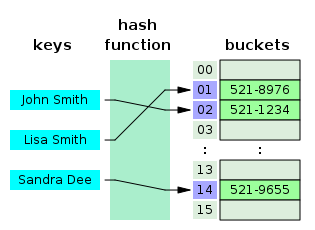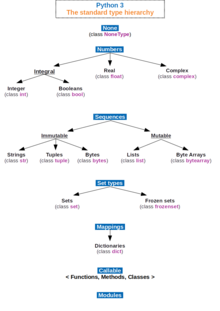What Are Data Structures Used For

In informatics, a data construction is a information organisation, direction, and storage format that is usually chosen for efficient access to data.[ane] [2] [3] More precisely, a data construction is a collection of information values, the relationships among them, and the functions or operations that can be applied to the data,[4] i.e., it is an algebraic structure about data.
Usage [edit]
Data structures serve as the basis for abstract data types (ADT). The ADT defines the logical form of the data type. The data construction implements the physical class of the information blazon.[5]
Different types of data structures are suited to different kinds of applications, and some are highly specialized to specific tasks. For example, relational databases normally use B-tree indexes for data retrieval,[half dozen] while compiler implementations normally utilise hash tables to await upward identifiers.[7]
Data structures provide a means to manage big amounts of data efficiently for uses such as large databases and net indexing services. Usually, efficient data structures are primal to designing efficient algorithms. Some formal design methods and programming languages emphasize data structures, rather than algorithms, as the primal organizing factor in software design. Information structures can be used to organize the storage and retrieval of information stored in both chief memory and secondary retentiveness.[eight]
Implementation [edit]
Data structures are generally based on the ability of a calculator to fetch and store data at any identify in its retentiveness, specified past a pointer—a fleck string, representing a memory address, that tin be itself stored in memory and manipulated past the plan. Thus, the assortment and record data structures are based on calculating the addresses of information items with arithmetic operations, while the linked data structures are based on storing addresses of data items within the structure itself.
The implementation of a data construction usually requires writing a fix of procedures that create and manipulate instances of that structure. The efficiency of a information construction cannot be analyzed separately from those operations. This observation motivates the theoretical concept of an abstract data type, a information structure that is defined indirectly by the operations that may be performed on it, and the mathematical properties of those operations (including their space and fourth dimension cost).[9]
Examples [edit]

The standard type bureaucracy of the programming linguistic communication Python 3.
There are numerous types of information structures, generally built upon simpler primitive data types. Well known examples are:[10]
- An array is a number of elements in a specific club, typically all of the aforementioned type (depending on the linguistic communication, private elements may either all be forced to be the same type, or may be of almost any blazon). Elements are accessed using an integer index to specify which element is required. Typical implementations allocate contiguous memory words for the elements of arrays (but this is not always a necessity). Arrays may be stock-still-length or resizable.
- A linked list (besides just called list) is a linear collection of information elements of any type, chosen nodes, where each node has itself a value, and points to the next node in the linked list. The principal advantage of a linked list over an array is that values can always exist efficiently inserted and removed without relocating the remainder of the list. Sure other operations, such as random access to a certain element, are however slower on lists than on arrays.
- A record (too called tuple or struct) is an aggregate data structure. A record is a value that contains other values, typically in fixed number and sequence and typically indexed by names. The elements of records are normally called fields or members. In the context of object-oriented programming, records are known as evidently old information structures to distinguish them from objects.[11]
- Hash tables, graphs and binary copse.
Language support [edit]
Nearly assembly languages and some depression-level languages, such equally BCPL (Basic Combined Programming Language), lack congenital-in support for data structures. On the other mitt, many high-level programming languages and some college-level associates languages, such as MASM, have special syntax or other built-in back up for sure data structures, such as records and arrays. For example, the C (a directly descendant of BCPL) and Pascal languages support structs and records, respectively, in addition to vectors (ane-dimensional arrays) and multi-dimensional arrays.[12] [xiii]
Most programming languages characteristic some sort of library mechanism that allows information structure implementations to be reused by unlike programs. Mod languages usually come with standard libraries that implement the most common data structures. Examples are the C++ Standard Template Library, the Coffee Collections Framework, and the Microsoft .NET Framework.
Modern languages also generally support modular programming, the separation between the interface of a library module and its implementation. Some provide opaque data types that allow clients to hide implementation details. Object-oriented programming languages, such as C++, Coffee, and Smalltalk, typically employ classes for this purpose.
Many known data structures have concurrent versions which allow multiple computing threads to admission a single physical example of a data construction simultaneously.[fourteen]
See also [edit]
- Abstract data type
- Concurrent data structure
- Information model
- Dynamization
- Linked data structure
- List of data structures
- Persistent data construction
- Patently old information structure
- Queap
- Succinct data structure
- Tree (data construction)
References [edit]
- ^ Cormen, Thomas H.; Leiserson, Charles E.; Rivest, Ronald L.; Stein, Clifford (2009). Introduction to Algorithms, 3rd Edition (3rd ed.). The MIT Press. ISBN978-0262033848.
- ^ Black, Paul E. (xv December 2004). "data structure". In Pieterse, Vreda; Blackness, Paul East. (eds.). Dictionary of Algorithms and Data Structures [online]. National Institute of Standards and Technology. Retrieved 2018-eleven-06 .
- ^ "Information structure". Encyclopaedia Britannica. 17 Apr 2017. Retrieved 2018-eleven-06 .
- ^ Wegner, Peter; Reilly, Edwin D. (2003-08-29). Encyclopedia of Computer science. Chichester, UK: John Wiley and Sons. pp. 507–512. ISBN978-0470864128.
- ^ "Abstract Information Types". Virginia Tech - CS3 Data Structures & Algorithms.
- ^ Gavin Powell (2006). "Chapter 8: Building Fast-Performing Database Models". Kickoff Database Design. Wrox Publishing. ISBN978-0-7645-7490-0.
- ^ "1.v Applications of a Hash Table". University of Regina - CS210 Lab: Hash Table. Archived from the original on 2021-04-27. Retrieved 2018-06-14 .
- ^ "When data is too big to fit into the principal memory". homes.sice.indiana.edu.
- ^ Dubey, R. C. (2014). Advanced biotechnology : For B Sc and K Sc students of biotechnology and other biological sciences. New Delhi: S Chand. ISBN978-81-219-4290-iv. OCLC 883695533.
- ^ Seymour, Lipschutz (2014). Data structures (Revised first ed.). New Delhi, Republic of india: McGraw Hill Education. ISBN9781259029967. OCLC 927793728.
- ^ Walter E. Brown (September 29, 1999). "C++ Linguistic communication Notation: POD Types". Fermi National Accelerator Laboratory. Archived from the original on 2016-12-03. Retrieved half-dozen December 2016.
- ^ "The GNU C Manual". Costless Software Foundation. Retrieved 2014-10-15 .
- ^ Van Canneyt, Michaël (September 2017). "Costless Pascal: Reference Guide". Complimentary Pascal.
- ^ Mark Moir and Nir Shavit. "Concurrent Data Structures" (PDF). cs.tau.ac.il.
Bibliography [edit]
- Peter Brass, Advanced Data Structures, Cambridge Academy Press, 2008, ISBN 978-0521880374
- Donald Knuth, The Art of Estimator Programming, vol. 1. Addison-Wesley, 3rd edition, 1997, ISBN 978-0201896831
- Dinesh Mehta and Sartaj Sahni, Handbook of Data Structures and Applications, Chapman and Hall/CRC Press, 2004, ISBN 1584884355
- Niklaus Wirth, Algorithms and Data Structures, Prentice Hall, 1985, ISBN 978-0130220059
Further reading [edit]
- Alfred Aho, John Hopcroft, and Jeffrey Ullman, Information Structures and Algorithms, Addison-Wesley, 1983, ISBN 0-201-00023-7
- One thousand. H. Gonnet and R. Baeza-Yates, Handbook of Algorithms and Data Structures - in Pascal and C, second edition, Addison-Wesley, 1991, ISBN 0-201-41607-seven
- Ellis Horowitz and Sartaj Sahni, Fundamentals of Data Structures in Pascal, Computer Science Press, 1984, ISBN 0-914894-94-iii
External links [edit]
- Descriptions from the Dictionary of Algorithms and Information Structures
- Data structures class
- An Examination of Data Structures from .Cyberspace perspective
- Schaffer, C. Information Structures and Algorithm Analysis
What Are Data Structures Used For,
Source: https://en.wikipedia.org/wiki/Data_structure
Posted by: haydenconevenibary.blogspot.com


0 Response to "What Are Data Structures Used For"
Post a Comment